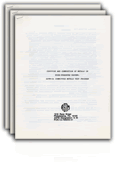We need your consent to use the individual data so that you can see information about your interests, among other things. Click "OK" to give your consent.
ASTM G94-22
Standard Guide for Evaluating Metals for Oxygen Service
Translate name
STANDARD published on 1.5.2022
The information about the standard:
Designation standards: ASTM G94-22
Publication date standards: 1.5.2022
SKU: NS-1066664
The number of pages: 32
Approximate weight : 96 g (0.21 lbs)
Country: American technical standard
Category: Technical standards ASTM
The category - similar standards:
Annotation of standard text ASTM G94-22 :
Keywords:
alloys, autoignition, autoignition temperature, burn ratios, calorimetry, combustion, flammability, friction/rubbing, gaseous impact, heat of combustion, ignition, LOX/GOX compatibility, materials selection, mechanical impact, metal combustion, metal flammability, metals, oxygen, oxygen index, oxygen service, particle impact, promoted combustion, sensitivity,, ICS Number Code 77.060 (Corrosion of metals)
These adjuncts apply to this standard:
Adjunct to G94 Guide for Evaluating Metals for Oxygen Service
Selected format:Show all technical information.
Additional information
| Significance and Use | ||||||||||||||||||||||||
|
4.1?The purpose of this guide is to furnish qualified technical personnel with pertinent information for use in selecting metals for oxygen service in order to minimize the probability of ignition and the risk of explosion or fire. It is intended for use in selecting materials for applications in connection with the production, storage, transportation, distribution, or use of oxygen. 1.1?This guide applies to metallic materials under consideration for oxygen or oxygen-enriched fluid service, direct or indirect, as defined in Section 3. It is concerned primarily with the properties of a metallic material associated with its relative susceptibility to ignition and propagation of combustion. It does not involve mechanical properties, potential toxicity, outgassing, reactions between various materials in the system, functional reliability, or performance characteristics such as aging, shredding, or sloughing of particles, except when these might contribute to an ignition. 1.2?This document applies only to metals; nonmetals are covered in Guide G63. Note 1:?The American Society for Testing and Materials takes
no position respecting the validity of any evaluation methods
asserted in connection with any item mentioned in this guide. Users
of this guide are expressly advised that determination of the
validity of any such evaluation methods and data and the risk of
use of such evaluation methods and data are entirely their own
responsibility.
Note 2:?In evaluating materials, any mixture with oxygen
exceeding atmospheric concentration at pressures higher than
atmospheric should be evaluated from the hazard point of view for
possible significant increase in material
combustibility.
1.3?UnitsThe values stated in SI units are to be regarded as the standard. 1.4?This standard does not purport to address all of the safety concerns, if any, associated with its use. It is the responsibility of the user of this standard to establish appropriate safety, health, and environmental practices and determine the applicability of regulatory limitations prior to use. 1.5?This international standard was developed in accordance with internationally recognized principles on standardization established in the Decision on Principles for the Development of International Standards, Guides and Recommendations issued by the World Trade Organization Technical Barriers to Trade (TBT) Committee. |
||||||||||||||||||||||||
| 2. Referenced Documents | ||||||||||||||||||||||||
|




 Cookies
Cookies
